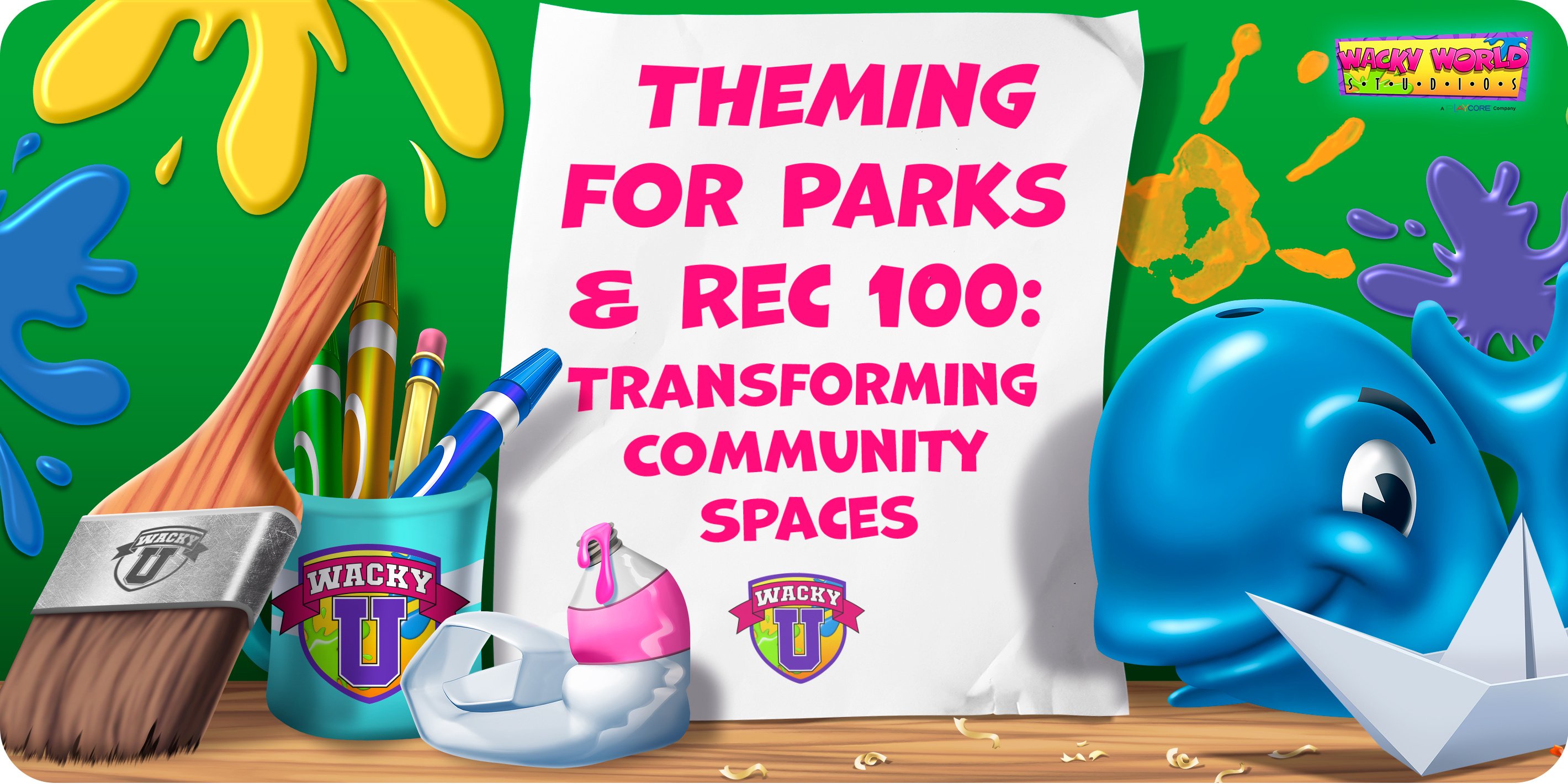Outdoor Spaces, Indoor Spaces, Parks & Rec
Maximizing Engagement in Parks & Recreation
July 22, 2024
In today's fast-paced world, parks and recreational areas serve as vital community hubs where people can connect, relax, and engage in various activities. However, the challenge lies in making these spaces not only functional but also inviting and exciting. Enter immersive theming—an innovative approach that can transform ordinary community spaces into vibrant, engaging environments. Here’s how immersive theming can maximize engagement and create memorable experiences.
Course Syllabus
Understanding the Importance of Immersive Theming
Strategies for Creating Immersive Community Spaces
- Identify and Understand the Audience
- Select and Engaging Theme
- Inclusivity
- Multi-Use Spaces
- Technology Integration and Educational Elements
- Collaborate with Local Artists and Organizations
- Community Involvement and Continuous Improvement
Challenges and Considerations
- Budget Constraints
- Maintenance
- Weather and Durability
- Accessibility
- Community Buy-In
- Balancing Aesthetics and Functionality
Final Exam
Understanding the Importance of Immersive Theming
Immersive theming involves creating an environment that transports visitors into a different world, making them feel part of a story or a specific setting. This concept goes beyond simple decorations; it’s about crafting a cohesive and interactive experience that stimulates the senses and encourages exploration.
The "Why" Behind Immersive Theming
1. Enhanced Visitor Experience: Immersive theming transforms spaces into destinations. When visitors step into a themed environment, they are transported to a different place and time, enhancing their overall experience. This transformation can create lasting memories, encouraging repeat visits and word-of-mouth promotion.2. Increased Engagement and Interaction: Themed spaces are designed to be interactive and engaging. By stimulating the senses and encouraging participation, these environments foster higher levels of engagement.
3. Educational Opportunities: Theming can incorporate educational elements that make learning enjoyable. For example, a park themed around local history can provide educational plaques and interactive exhibits, offering visitors a chance to learn about their community in an engaging way. Educational play is particularly beneficial for children, promoting cognitive development and a love for learning.
4. Community Identity and Pride: Themed spaces can reflect the unique culture, history, and values of a community. This reflection fosters a sense of pride and identity among residents. When a park or community space tells the story of its people, it strengthens the community bond and creates a shared sense of belonging.
5. Economic Benefits: Well-themed spaces can attract tourists as well as local residents and boost local economies. Increased foot traffic supports local businesses, creates jobs, and can lead to increased property values in the surrounding areas. According to the National Recreation and Park Association (NRPA), local park and recreation agencies in the United States generated nearly $201 billion in economic activity and supported over 1.1 million jobs in 2021 (NRPA).
Strategies for Creating Immersive Community Spaces
1. Identify and Understand the Audience
Knowing the demographics and preferences of the community is crucial. This understanding can be achieved through surveys, community meetings, and workshops. Engaging with the community helps gather insights into what residents want from their parks, ensuring that the final design meets their needs and desires. According to the American Planning Association “Community engagement allows mayors and public officials to directly involve their constituencies in the ongoing design, planning, and management of these resources. This process results in informed and engaged residents that feel better connected to their communities.” (APA).
2. Select an Engaging Theme
Choosing the right theme is pivotal. It should be relevant to the community and have broad appeal. Themes can be drawn from various inspirations:
- Nature and Adventure: These themes encourage exploration and interaction with nature. Research has shown that nature-themed parks can significantly enhance visitor engagement and well-being (Europarc Federation). Indoor spaces such as recreation centers can adopt nature themes by incorporating elements like indoor climbing walls that mimic rock faces or play areas designed to look like enchanted forests.
- Historical and Cultural: Reflecting local history or cultural heritage can instill a sense of pride and belonging. A park themed around local historical events or cultural practices can include educational plaques, interactive exhibits, and sculptures that tell the story of the community's past.
- Fantasy and Imagination: Spaces designed around fairy tales, superheroes, or futuristic worlds captivate the imagination of children and adults alike. These parks can feature whimsical structures, colorful murals, and interactive installations that transport visitors to a different realm. Indoor play areas can be transformed into magical worlds with themed playground equipment, interactive installations, and storybook murals.
3. Inclusivity
Creating a space that everyone can enjoy fosters a sense of community and belonging. Inclusive design features ensure that the park is accessible to all, including individuals with disabilities, the elderly, and families with young children. This includes providing ramps, sensory-friendly areas, and diverse play equipment. A cohesive theme can help to provide direction for the selection and placement of these features. The CDC highlights the importance of inclusive playgrounds for promoting social inclusion and physical activity (CDC).
Continuous engagement with the community helps in making necessary adjustments and improvements. An ongoing dialogue with park users ensures that the space evolves to meet their needs.
4. Multi-Use Spaces
Maximizing the utility of community spaces often involves designing areas that can serve multiple purposes. For example:
- Parks: Create open lawns that can host events, sports, picnics, and more. Install movable seating and modular play equipment that can be rearranged based on the activity or event.
- Indoor Facilities: Design multipurpose rooms in community centers that can be easily transformed to host different activities, such as fitness classes, art workshops, community meetings, and social events. Use modular furniture and movable walls to create flexible spaces.
Incorporating a consistent theme throughout these multi-use spaces ensures that regardless of the event or activity, the space remains engaging and visually appealing.
5. Technology Integration and Educational Elements
Interactive elements can transform a passive space into an active, engaging environment. These features encourage visitors to explore and interact with their surroundings in meaningful ways. A cohesive theme can help to provide a narrative and direction for the implementation of technology or other interactive features. Examples include:
- Touchable Sculptures: Sculptures that invite visitors to touch and interact with them, creating a tactile experience.
- Sensory Gardens: Gardens designed to engage all five senses with a variety of plants, textures, colors, and scents.
- Augmented Reality Games: Use technology to create games that overlay digital content on the physical environment, encouraging exploration and play.
- Learning Opportunities: Blend fun with education by creating themed zones that teach children about nature, history, or science through play. These educational elements make the park visit enriching and memorable, promoting lifelong learning and curiosity.
Interactive spaces, whether indoors or outdoors, can also foster social interaction and physical activity, contributing to a vibrant community atmosphere. “Research has shown that interactive games are not only a marvelously effective learning tool, but also cause kids to play longer, harder and more often. In addition, parents can access a dashboard showing their children’s physical activity profile, and parks are provided with a wealth of data, including usage patterns, distance walked, and challenges engaged with and solved.” (NRPA)
6. Collaborate with Local Artists and Organizations
Enhance your chosen theme by working with local artists and organizations. These features can infuse community spaces with unique character and strengthen community ties.
- Art Installations: Commission local artists to create sculptures, murals, and other art installations that reflect the community’s culture and values.
- Collaborative Projects: Partner with schools, cultural organizations, and community groups to develop themed areas and programs that involve the community and promote local talent.
7. Community Involvement and Continuous Improvement
To keep community spaces vibrant and engaging, it’s important to engage in continuous improvement and gather feedback from visitors. Involve the community throughout the design process and in its continued maintenance to ensure that the park reflects the desires and needs of its users. Methods of engagement can include:
- Brainstorming Sessions: Host workshops where community members can share their ideas and visions for the park. Theming can have the added benefit of limiting the idea generation to innovations and additions that improve or enhance the theme.
- Surveys and Polls: Use online and offline surveys to gather feedback on proposed designs and features.
- Feedback Mechanisms: Install suggestion boxes and conduct regular surveys to gather feedback from park users. Use this feedback to make ongoing improvements and updates.
- Pilot Programs: Test new ideas and themes with pilot programs before implementing them on a larger scale. This allows for experimentation and refinement based on visitor responses.
- Volunteer Opportunities: Encourage community members to participate in park maintenance, event planning, and programming.
Community involvement fosters a sense of ownership and pride, leading to higher engagement and care for the space.
Challenges and Considerations
While immersive theming offers numerous benefits, there are challenges and considerations to keep in mind:
- Budget Constraints: Theming can be expensive, particularly if it involves elaborate structures and technology. It's important to balance creativity with practicality and seek funding opportunities such as grants, sponsorships, and community fundraising.
- Maintenance: Themed environments require regular maintenance to ensure they remain safe and attractive. Plan for ongoing maintenance costs and develop a maintenance schedule to keep the space in good condition.
- Weather and Durability: For outdoor spaces, choose materials that can withstand various weather conditions. Indoor spaces also need durable materials that can handle high traffic and frequent use.
- Accessibility: Ensure that themed elements are accessible to all, including individuals with disabilities. This includes designing paths, seating, and interactive elements that can be used by everyone.
- Community Buy-In: Successful theming projects require community support and involvement. Engage the community throughout the planning and implementation process to build buy-in and ensure the final design meets their needs.
- Balancing Aesthetics and Functionality: While theming is important, it's crucial to maintain the functionality of the space. Ensure that themed elements do not obstruct pathways, limit visibility, or create safety hazards.
By addressing these challenges and considerations, parks and recreational areas can create immersive themed environments that are engaging, inclusive, and sustainable.
Conclusion
Immersive theming in community spaces, both outdoor and indoor, is a powerful tool for enhancing engagement, promoting well-being, and fostering a sense of community. By understanding the audience, selecting captivating themes, incorporating interactive and educational elements, and committing to inclusivity, parks and recreational areas can become dynamic spaces that inspire and delight.
Indoor facilities, such as community centers, recreation centers, and libraries, can also benefit from immersive theming, creating inviting environments that encourage participation and learning. As communities continue to evolve, the role of well-designed, immersive spaces will become increasingly important in promoting community engagement and enhancing the quality of life.
With thoughtful planning and creative execution, parks and recreational facilities can transform into true centers of community life, offering memorable experiences and fostering a sense of pride and belonging among residents.
Stay in the know with Wacky World Studios! We're here to help you with all stages of your theming journey. Make sure you sign up for our monthly newsletter and subscribe to this blog for even more handy theming resources and information. You can also get lots of great inspiration when you follow us on social. Our Pinterest and Instagram pages are overflowing with photos and ideas.
Ready to test your knowledge?
Subscribe here for Wacky U updates!
And for you DIYers, be sure to check out our online shop at WackyWorldDIY.com.


